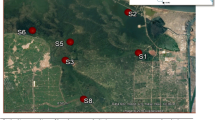Abstract
Water samples were collected from the mouths of the three major agricultural watersheds, the Grand, the Saugeen, and the Thames (Ontario, Canada), between January 1986 and December 1990. Analyses were performed for 18 herbicides, 26 insecticides, and 4 fungicides in use in the basins. A total of between 425 and 474 samples were analyzed for each of the major groups of pesticides. Six herbicides, two insecticides and polychlorinated biphenyls (PCBs) were identified in surface water. Atrazine and its metabolite desethylatrazine were the most frequently found pesticide present in 340 of 474 samples or 72%; the metabolite was not always present with the parent compound. The second most frequently found pesticide was metolachlor which was identified in 30 of 474 samples or 6.3%. 2,4-D and cyanazine were present in 3.3% and 1.5% of the samples, respectively; alachlor, mecoprop, and simazine were present in 0.5% of the samples. Dicamba and metribuzin were present in single samples (0.2%). DDT, heptachlor epoxide, and PCB were identified in only single samples over the 5-year period. Between 342 and 2959 kg/annum of total atrazine were found passing the mouth of the three rivers and entering Lakes Erie or St. Clair between 1986 and 1990. The greatest loss was from the Thames River and the least from the Saugeen River. Between 1% and 2% of that applied in the watershed was lost at the mouth. Loadings of only two other pesticides to the rivers exceeded 5 kg in any one year, namely, metolachlor and 2,4-D. In the case of metolachlor, loadings ranged from <5 to 1,726 kg/annum, the highest being in the Thames and the lowest in the Saugeen River. 2,4-D exceeded a loading of 5 kg/annum in 1988 in the Grand River. Atrazine, cyanazine, and metolachlor were tracked across Lake St. Clair from the mouth of the Thames to the mouth of the Detroit River in 1987.
Similar content being viewed by others
References
Anonymous (1977) International Reference Group on Great Lakes Pollution from Land Use Activities (PLUARG). Quality control handbook for pilot watershed studies, International Joint Commission, Windsor, Ontario, Canada
-(1978) Environmental management strategy for the Great Lakes System. Pollution from Land Use Activities Reference Group (PLUARG). Final Report, International Joint Commission, Windsor, Ontario, Canada
-Anonymous (1986–1990) Environment Canada, Water Survey of Canada, Inland Waters and Lands Directorate, Water Resources Branch, Water Survey of Canada, Ottawa, Canada
-Anonymous (1988) 1987 Agricultural Statistics for Ontario, Ontario Ministry of Agriculture and Food Publication 20, ISSN 0568-2894, Parliament Buildings, Queen's Park, Toronto, Ontario, Canada
Beste LE (ed) (1983) Herbicide Handbook, Fifth edition, Weed Science Society of America, Champaign, IL
Bodo B, Unny TE (1983) Sampling strategies for mass discharge estimation. J Environ Eng Vol 109, No. 4, ASCE, Paper No. 18139
Coburn JA, Ripley BD, Chau ASY (1976) Analysis of pesticide residues by chemical derivatization. II.N-Methyl-carbamates in natural water and soils. J Assoc Offic Anal Chem 59:188–196
Coote DR, MacDonald EM, Dickinson WT, Ostry RL, Frank R (1982) Agriculture and water quality in the Canadian Great Lakes Basin: I. Representative agricultural watersheds. J Environ Qual 11:473–481
Felsot AS, Mitchell JK, Kenimer A (1990) Assessment of management practices for reducing pesticide runoff for sloping cropland in Illinois. J Environ Qual 19:535–545
Frank R (1981) Pesticides and PCB in the Grand and Saugeen River basins. J Great Lakes Res 7(4):440–454
Frank R, Braun HE, Sirons GJ, Holdrinet MHV, Ripley BD, Onn D, Coote R (1978) Stream flow quality-pesticides in eleven agricultural watersheds in Southern Ontario, Canada 1974–1977. PLUARG Tech Rep Int Joint Commissions, Windsor, Ontario, Canada
Frank R, Braun HE, Holdrinet MVH, Sirons GJ, Ripley BD (1982) Agriculture and water quality in the Canadian Great Lakes Basin: V. Pesticide use in 11 agricultural watersheds and presence in stream water, 1975–1977, J Environ Quality 11:497–505
Frank R, Clegg BS, Patni NK (1991) Dissipation of cyanazine and metolachlor on a clay loam soil, Ontario, Canada, 1987–1990. Arch Environ Contam Toxico 21:253–262
Frank R, Logan L (1988) Pesticide and industrial chemical residues at the mouth of the Grand, Saugeen and Thames rivers, Ontario, Canada 1981–85. Arch Environ Contam Toxicol 17:741–754
Haith DA (1986) Simulated regional variations in pesticide runoff. J Environ Qual 15:5–8
Hall JK, Pawlus M, Higgins ER (1972) Losses of atrazine in runoff water and soil sediment. J Environ Qual 1:172–176
Holdrinet M (1974) Determination and confirmation of hexachlorobenzene in fatty samples in the presence of other residual halogenated hydrocarbon pesticides and polychlorinated biphenyls. J Assoc Offic Anal Chem 57:580–584
Holdrinet MVH, Frank R, Thomas RL, Hetling LH (1978) Mirex in the sediments of Lake Ontario. J Great Lakes Res 4:69–74
Mills PA, Bong BA, Kamps LR, Burke JA (1972) Elution solvent for Florisil® cleanup in organochlorine pesticide residue analysis. J Assoc Offic Anal Chem 55:39–43
Moxley (1989) Survey of pesticide use in Ontario 1988. Economics Information Report 89-08, ISBN 0-7743-99459-7 Ont Ministry of Agriculture and Food, Legislative Buildings, Queen's Park, Toronto, Ontario, Canada M7A 1B6
Ramsteiner K, Hormann WD, Eberle DO (1974) Multi-residue method for the determination of triazine herbicides in field-grown agricultural crops, water, and soil. J Assoc Offic Anal Chem 57:192–201
Ripley BD (1985) Gas chromatography—mass spectrometry of acylalanine fungicides. J Agric Food Chem 33:560–563
Sirons GJ, Frank R, Sawyer T (1973) Residues of atrazine, cyanazine and their phytotoxic metabolites in a clay loam soil. J Agric Food Chem 21:1016–1020
Statistics Canada (1981) Census of Agriculture, Ontario, Catalogue No. 96–907, Ottawa, Canada
Worthing CR, Walker SB (1983) The pesticide manual, 7th ed. Brit Crop Prot Council, Croyden, UK
Yip G (1971) Improved methods for determination of chlorophenoxy acid residues in total diet samples. J Assoc Offic Anal Chem 54:966–969
Author information
Authors and Affiliations
Rights and permissions
About this article
Cite this article
Frank, R., Logan, L. & Clegg, B.S. Pesticide and polychlorinated biphenyl residues in waters at the mouth of the Grand, Saugeen, and Thames Rivers, Ontario, Canada, 1986–1990. Arch. Environ. Contam. Toxicol. 21, 585–595 (1991). https://doi.org/10.1007/BF01183882
Received:
Issue Date:
DOI: https://doi.org/10.1007/BF01183882




